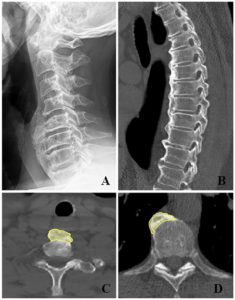Hyperostosis indicates that it’s possible to form new bone as an adult. Hyperostosis seems to affect ligaments which would make it hard for height growth as there ligaments really placed to add to height. It may be linked to insulin as diabetes may affect hyper ostosis.
Morphological characteristics of diffuse idiopathic skeletal hyperostosis in the cervical spine.
“(A) Plain lateral radiograph shows a 69 year old male with DISH in the cervical spine. A solid formation of new bone is extending over at least four vertebral bodies. (B) Computed tomography (CT) visualizes the thoracic spine of a 72 year old male in the sagittal view. The scan shows a flowing ossification of the anterolateral spine with bridging over more than four contiguous vertebral bodies. The intervertebral discs and apophyseal joints are relatively intact in both images. (C + D) The CT scans in axial view demonstrate the differences in position of the new bone formation depending on the region. (C) The CT scan of the cervical spine corresponds to the radiographic image (A) and demonstrates symmetrical hyperostosis (yellow) anterior to the vertebral body and possible displacement of the trachea. (D) The axial CT of the mid thoracic spine in a 58 year old male with DISH shows the newly formed bone on the right anterolateral side with the aorta clearly located on the left anterolateral side.”<-So this is all over time.
“It has been hypothesized that vascular structures act as a natural barrier for the formation of new bone in DISH”
If blood vessels do block bone growth than that fact can be exploited to increase height. There is an epiphyseal artery though that doesn’t block growth.
“arteries may act as a natural barrier for newly formed bone in DISH. The lack of crossing segmental vessels in the cervical spine may permit linear bone growth creating a bar-like structure in contrast to the flowing pattern typical for DISH in the thoracic spine where segmental vessels are present.”

